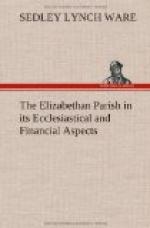We come now to Communion Dues, or Collections taken up at the time of communion.
“Paschall money” is defined in a vestry order of Stepney parish, London, in 1581 as a duty of 1d. paid by each communicant at Easter “toward the charge of breade and wine over and besides theyre offering mony due unto the vicar.” These paschal dues, the order further informs us, had long been farmed by the vicar for 40s. yearly. But now the yield of a penny from each communicant was “thought a thing so profitable and beneficiall,” that only as a special mark of favor was the vicar to continue to farm it, but at L4 thenceforth instead of at 40s.[278] “Easter money,” an expression found not infrequently in the accounts, may have referred to the same payment, or it may have designated the offering which generally followed the celebration of communion,[279] taken up, doubtless, from all those present, whether communicating or not, the proceeds of which might go to the minister or to the parish according to agreement or custom.
Though the Second Edwardine Prayer Book (1552) provided that the elements were to be found by the curate and the wardens at the expense of the parish, which was then to be discharged of fees, or levies on each household, nevertheless, we meet with Communion Fees or with house-to-house levies to defray the cost of bread and wine in many parishes during Elizabeth’s reign.[280] In order to ensure payment of the communion fee, tokens (or as we would say today, tickets) were provided in some parishes which were first to be handed in before the ministrant admitted the applicant to reception.[281]
In a number of parishes a fine wine such as muscatel or malmsey was provided for the better sort, or the masters and mistresses, while the servants, or poorer folk, were served with claret.[282] Indeed where all were compelled to communicate thrice yearly the cost of wine was a very serious item.
Collections for the Holy Loaf, that is, blessed but not consecrated bread, which went to defray the costs of administering the Eucharist, occur in some of the earlier Elizabethan accounts.[283] Surplus communion fee money, or communion offerings were devoted to the care of the poor and other expenses.[284]
The heading Clerk’s Wages, which is so often met with in the wardens’ receipt items, frequently serves (as do several other special headings) as a mere peg on which to hang a collection for various or even for general parish expenses.[285]
Pews and Seats in Church were often made a source of revenue. Thus at St. Mary’s, Reading, it was agreed in 1581 by the chief men of the parish, in order to augment the parish stock and to maintain the church, because “the rentes ar very smale,” that those sitting in front seats in the church should pay 8d., those behind them 6d., the third row 4d., and so on.[286]




